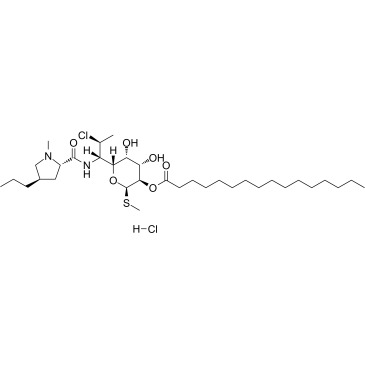
Clindamycin palmitate HCl
CAS No. 25507-04-4
Clindamycin palmitate HCl( —— )
Catalog No. M18316 CAS No. 25507-04-4
Clindamycin palmitate HCl is a water soluble hydrochloride salt of the ester of clindamycin and palmitic acid and a lincosamide antibiotic.
Purity : >98% (HPLC)
 COA
COA
 Datasheet
Datasheet
 HNMR
HNMR
 HPLC
HPLC
 MSDS
MSDS
 Handing Instructions
Handing Instructions
| Size | Price / USD | Stock | Quantity |
| 50MG | 38 | Get Quote |


|
| 100MG | 59 | Get Quote |


|
| 200MG | Get Quote | Get Quote |


|
| 500MG | Get Quote | Get Quote |


|
| 1G | Get Quote | Get Quote |


|
Biological Information
-
Product NameClindamycin palmitate HCl
-
NoteResearch use only, not for human use.
-
Brief DescriptionClindamycin palmitate HCl is a water soluble hydrochloride salt of the ester of clindamycin and palmitic acid and a lincosamide antibiotic.
-
DescriptionClindamycin palmitate HCl is a water soluble hydrochloride salt of the ester of clindamycin and palmitic acid and a lincosamide antibiotic.
-
In Vitro——
-
In Vivo——
-
Synonyms——
-
PathwayOthers
-
TargetOther Targets
-
RecptorOthers
-
Research AreaOthers-Field
-
Indication——
Chemical Information
-
CAS Number25507-04-4
-
Formula Weight699.85
-
Molecular FormulaC34H63ClN2O6S·HCl
-
Purity>98% (HPLC)
-
SolubilityIn Vitro:?DMSO : 125 mg/mL (178.61 mM)
-
SMILESCCCCCCCCCCCCCCCC(=O)O[C@@H]1[C@H]([C@H]([C@H](O[C@@H]1SC)[C@@H]([C@H](C)Cl)NC(=O)[C@@H]2C[C@H](CN2C)CCC)O)O.Cl
-
Chemical Name——
Shipping & Storage Information
-
Storage(-20℃)
-
ShippingWith Ice Pack
-
Stability≥ 2 years
Reference
1.Bystrzycka W, et al.Cent Eur J Immunol. 2016;41(1):1-5.
molnova catalog



related products
-
Caracemide
Caracemide inhibits the enzyme ribonucleotide reductase of Escherichia coli. Caracemide can be used in anticancer studies.
-
4-Chloro-3-nitrobenz...
4-Chloro-3-nitrobenzoic acid is a chemical compound.
-
10-Methoxygambogenic...
10-Methoxygambogenic acid is highly cytotoxic to HL-60, SMMC-7721 and BGC-83 cells.



 Cart
Cart
 sales@molnova.com
sales@molnova.com


